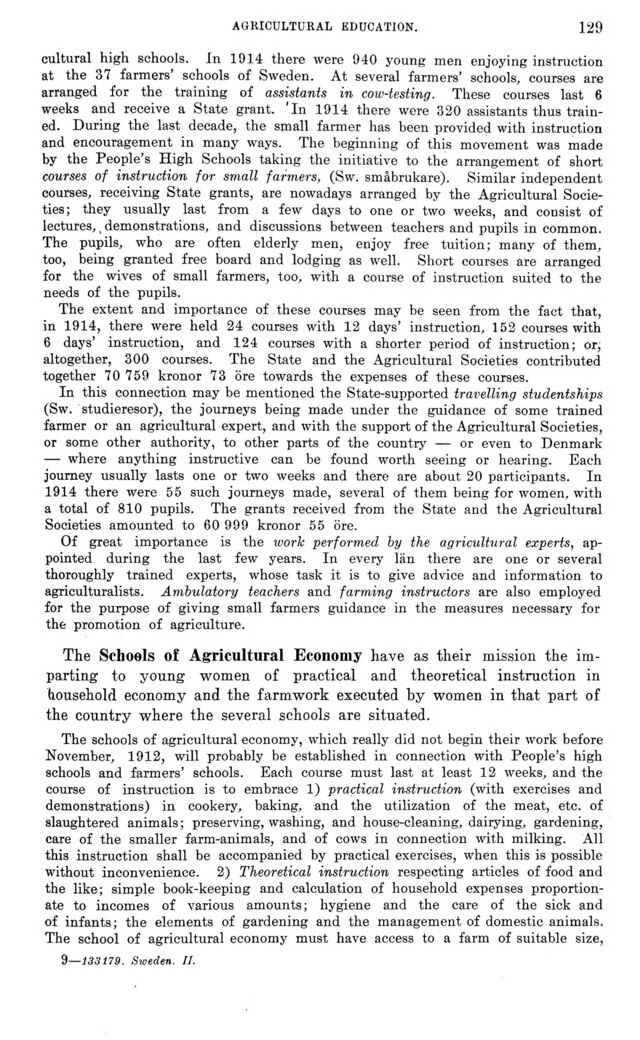
Full resolution (JPEG) - On this page / på denna sida - III. Rural Husbandry. Introd. by H. Juhlin Dannfelt - 4. Public and Private Institutions for the Advancement of Agriculture. Introd. by W. Flach - Agricultural Education. By L. Holmström

<< prev. page << föreg. sida << >> nästa sida >> next page >>
Below is the raw OCR text
from the above scanned image.
Do you see an error? Proofread the page now!
Här nedan syns maskintolkade texten från faksimilbilden ovan.
Ser du något fel? Korrekturläs sidan nu!
This page has never been proofread. / Denna sida har aldrig korrekturlästs.
agricultural education.
129
cultural high schools. In 1914 there were 940 young men enjoying instruction
at the 37 farmers’ schools of Sweden. At several farmers’ schools, courses are
arranged for the training of assistants in cow-testing. These courses last 6
weeks and receive a State grant. ’In 1914 there were 320 assistants thus
trained. During the last decade, the small farmer has been provided with instruction
and encouragement in many ways. The beginning of this movement was made
by the People’s High Schools taking the initiative to the arrangement of short
courses of instruction for small farmers, (Sw. småbrukare). Similar independent
courses, receiving State grants, are nowadays arranged by the Agricultural
Societies; they usually last from a few days to one or two weeks, and consist of
lectures,, demonstrations, and discussions between teachers and pupils in common.
The pupils, who are often elderly men, enjoy free tuition; many of them,
too, being granted free board and lodging as well. Short courses are arranged
for the wives of small farmers, too, with a course of instruction suited to the
needs of the pupils.
The extent and importance of these courses may be seen from the fact that,
in 1914, there were held 24 courses with 12 days’ instruction, 152 courses with
6 days’ instruction, and 124 courses with a shorter period of instruction; or,
altogether, 300 courses. The State and the Agricultural Societies contributed
together 70 759 kronor 73 öre towards the expenses of these courses.
In this connection may be mentioned the State-supported travelling studentships
(Sw. studieresor), the journeys being made under the guidance of some trained
farmer or an agricultural expert, and with the support of the Agricultural Societies,
or some other authority, to other parts of the country — or even to Denmark
— where anything instructive can be found worth seeing or hearing. Each
journey usually lasts one or two weeks and there are about 20 participants. In
1914 there were 55 such journeys made, several of them being for women, with
a total of 810 pupils. The grants received from the State and the Agricultural
Societies amounted to 60 999 kronor 55 öre.
Of great importance is the work performed by the agricultural experts,
appointed during the last few years. In every län there are one or several
thoroughly trained experts, whose task it is to give advice and information to
agriculturalists. Ambulatory teachers and farming instructors are also employed
for the purpose of giving small farmers guidance in the measures necessary for
the promotion of agriculture.
The Sehoels of Agricultural Economy have as their mission the
imparting to young women of practical and theoretical instruction in
household economy and the farmwork executed by women in that part of
the country where the several schools are situated.
The schools of agricultural economy, which really did not begin their work before
November, 1912, will probably be established in connection with People’s high
schools and farmers’ schools. Each course must last at least 12 weeks, and the
course of instruction is to embrace 1) practical instruction (with exercises and
demonstrations) in cookery, baking, and the utilization of the meat, etc. of
slaughtered animals; preserving, washing, and house-cleaning, dairying, gardening,
care of the smaller farm-animals, and of cows in connection with milking. All
this instruction shall be accompanied by practical exercises, when this is possible
without inconvenience. 2) Theoretical instruction respecting articles of food and
the like; simple book-keeping and calculation of household expenses
proportionate to incomes of various amounts; hygiene and the care of the sick and
of infants; the elements of gardening and the management of domestic animals.
The school of agricultural economy must have access to a farm of suitable size,
9—133179. Sweden. II.
<< prev. page << föreg. sida << >> nästa sida >> next page >>